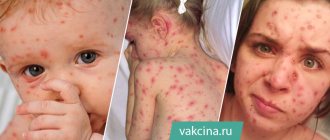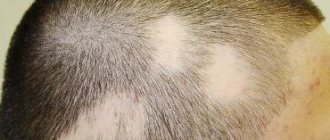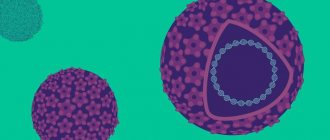When you hear the word “urticaria”, you immediately imagine redness of the skin, a rash and an unpleasant itching - you just want to scratch!.. Indeed, this disease (or rather, a whole group of diseases) has its name for a reason. Its manifestations are very similar to the consequences of a nettle “bite”.
Blisters and redness can be localized on various parts of the body - face, arms, legs, back, neck, etc., and after disappearing they do not leave any trace.
Urticaria can occur suddenly in any person (according to statistics, from 10 to 35% of the world's population suffer from it at least once in their lives), but should you be afraid of it? What are its causes and how to treat this disease? Is it dangerous? Let's figure it out.
“Oh, I’m blushing all over!..” But why?
Urticaria, or nettle fever, is an allergic disease. Hives can be either a direct reaction to an allergen or one of the manifestations of a wide range of diseases of a very different nature.
Hives are not contagious, and therefore you should not be afraid of people who are “showered” with red blisters.
However, there is one “but”... Often, urticaria occurs together with Quincke’s edema, which is its most dangerous feature.
The fact is that this swelling can spread to the mucous membrane of the larynx, which without urgent medical help can lead to respiratory arrest and death. Urticaria is divided into acute and chronic.
Acute nettle fever
It occurs suddenly and does not last long - from several hours to a couple of weeks. Acute urticaria can be caused by allergies to insect bites, food, or an infection that has affected the human body. This form of the disease is most common in children.
Causes of acute urticaria include allergic reactions to:
- food products (the most common cause of the disease);
- medications;
- insect bites (especially bees and wasps);
- weather and physical conditions (cold, heat, sun rays, vibration, pressure changes, etc.);
- other substances and materials that can act as an allergen (latex, animal saliva).
Infectious diseases can also cause acute urticaria.
Experts note that sometimes acute nettle fever becomes chronic, which requires longer and more complex treatment.
Chronic urticaria
As its name suggests, it lasts a long time. It can be observed for several months. The causes of this type of illness are more serious. These include disturbances in the functioning of various organs - the liver, kidneys, gastrointestinal tract, chronic infections, and toxicosis of pregnant women. Doctors say that chronic urticaria is an autoimmune pathology (this is the name for the phenomenon when the body mistakes its own cells for foreign ones and begins to fight them). It affects mostly adults, and women are especially susceptible to it.
However, a significant proportion of chronic urticaria does not have a clearly identified cause. In other words, this pathology has not yet revealed all its secrets, and therefore its danger, expressed in the likelihood of developing Quincke's edema and anaphylactic shock, has not decreased to this day.
Symptoms and causes
Urticaria is an acute skin reaction that develops over several minutes to hours.
Rash with urticaria - like a mosquito bite/stinging nettle:
- pink or white with a pinkish rim
- rise above the skin, turns pale when pressed
- from several mm to several cm, can merge, disappear and reappear
- occur on any part of the body
- accompanied by itching, usually worsens in the evening
- elements can appear one after another in new places
- one element usually lasts up to 24 hours (rarely longer), disappearing without a trace; in general, new elements can appear up to 6 weeks
- if urticaria occurs repeatedly for more than 6 weeks, then it is chronic urticaria
The most common reason that triggers the development of urticaria in children is a history of infection (which is why the cause often cannot be found).
Less commonly, the trigger is: foods (nuts, eggs, fish, tomatoes, shellfish, strawberries, etc.), food additives, medications (antibiotics, antipyretics), insect/jellyfish stings. The cause of chronic urticaria often remains unknown, it can be autoimmune in nature, be a consequence of hormonal disorders, disorders of the nervous system, allergies are almost never its cause
Also, by a similar mechanism, local swelling of the skin can occur, most often in the area of the eyelids, lips, and limbs. More often - after an insect bite, on fur, pollen, etc.
If you experience repeated urticaria, you should consult a pediatrician.
Typically, acute urticaria goes away within a day (rarely longer), does not threaten health and goes away on its own. First aid consists of a cold compress and the prescription of antihistamines (2nd generation).
If the cause was a specific allergen, then you need to avoid contact with it in the future.
The presence of acute urticaria in a child does not increase the risk of allergic reactions in the future, the risk of atopic dermatitis or other allergic diseases, and does not require adherence to a hypoallergenic diet or long-term prescription of antihistamines.
A dangerous reaction is accompanied by suffocation, difficulty speaking and breathing, hoarseness of voice, and bluish complexion.
Urticaria and its treatment: you can’t do without a doctor!
Let us remind you that, although urticaria itself is safe and goes away without a trace, the “companion” of this disease - Quincke's edema - can lead to serious consequences.
That is why you should pay utmost attention to the first signs of nettle fever and consult a doctor who will determine the causes of the disease and give the necessary recommendations. This is especially important if the rash appears in children.
If symptoms of anaphylactic shock appear (difficulty breathing and swallowing, in women - spasms and pain in the uterine area), you must immediately call an ambulance.
To determine the nature of the pathology, an allergist-immunologist will examine the patient and conduct the necessary tests and tests for allergens.
Having made conclusions about the causes of urticaria, the doctor will begin treatment. Patients with acute urticaria are prescribed antihistamines, and patients suffering from chronic urticaria also take immunomodulators.
It is important to remember that the treatment process will be quite long, but it will be most effective if you follow the correct lifestyle: you need to remove everything that can cause an allergic reaction, adhere to the diet recommended by your doctor, stop smoking and drinking alcohol.
Never take antihistamines unless prescribed by a specialist. By doing this you can only harm yourself and your body.
Viral urticaria
The situation seems to be banal, an acute respiratory infection, even a mild one, seems to have subsided, and then a characteristic rash like urticaria begins to appear. Moreover, in different areas, it disappears on its own, appearing either on the body, then on the face, or on the leg. Looks like an allergy. But for what? The child is put on a diet, the powder is looked at with suspicion, and the causative factor is still not clear. Most likely, the cause of hives is the virus itself. This is how the body releases histamine, trying to react and get rid of foreign “aliens”
Urticaria can also occur due to bacterial infections, for example, sore throat (streptococcus or urinary tract infections
UpToDate (medical decision support system (MDS)) says that 80% of hives in childhood are associated with viruses.
Viral urticaria:
- Usually occurs after acute respiratory viral infection, usually within a week
- Disturbs periodically with a characteristic rash for 1-2 weeks and then disappears on its own
- The rash looks like pink raised plaques; the center may be slightly lighter than the outline. Swelling around the plaques in viral urticaria is minimal.
- We saw children who lasted even a month or two, there was nothing to connect them with other than a virus
- There is no point in using antihistamine gels topically, as it migrates
- There may not be severe itching that bothers the child. But it can itch a lot - it depends on the individual.
- It is not contagious and the child can attend the group
- To say that taking antiallergic medications is indicated, but the allergen is still inside the body and it takes time for it to be removed from there, so antiallergic medications can be justified only if the symptoms are severe, for example, itching prevents a child from sleeping.
Diagnosis of urticaria
Despite the similarity of symptoms, the approach to diagnosis for acute and chronic urticaria is different. Laboratory tests are necessary in some cases to identify the cause of chronic and intermittent (episodic) acute urticaria. In most cases, the diagnosis is based on the anamnesis (history of the disease) and examination of the patient.
Contact/referral to a specialist (allergist-immunologist) is necessary in many cases of chronic urticaria to draw up a diagnostic plan (search for the main cause of the disease) and select treatment.
If allergic urticaria is suspected, an allergy test (skin tests and determination of specific antibodies in the blood) may be performed. To exclude concomitant pathology in chronic urticaria/angioedema, the spectrum of examination is determined by the allergist in each specific case individually.
Unfortunately, the cause of chronic urticaria and/or angioedema in most cases is not identified even after extensive examination. But such a patient remains under further medical supervision to detect symptoms of the disease that is causing the urticaria and adjust therapy in anticipation of spontaneous remission (cure) of the urticaria.
How to behave if you see characteristic rashes on a person
Knowing whether the disease is contagious or not, we can conclude: contact with a person with obvious signs of urticaria is allowed and it is absolutely safe. But only if these are symptoms of allergies, and not infections. It is difficult for the average person to distinguish the symptoms of infections from allergies. When in contact with a sick person, it is advisable to always keep your distance and be careful:
- try not to touch the rash with your hands or other parts of your naked body (especially if there are wounds);
- do not give away your personal belongings;
- wash your hands after touching a rash (for example, when a mother treats a child’s rash);
- do not communicate too closely;
- do not use the patient’s belongings (towels, clothes, dishes);
- do not have sexual intercourse.
Manifestations of allergies are similar to many contagious skin pathologies (herpes and others), so they are often confused. If a relative or loved one has a skin rash, you should persuade him to go to the hospital and get tested. Only in a hospital can you find out exactly what caused it and how to treat it. After successful treatment, to prevent relapses it is recommended:
- avoid contact with the irritant;
- change your lifestyle;
- maintain proper nutrition;
- treat infectious diseases (flu, acute respiratory viral infections and others) in a timely manner.
Not all pathologies are contagious. This should be remembered when contacting patients. Expressing your disgust can greatly offend. You need to react appropriately and calmly to a person with allergy symptoms.
Clinical picture
The development of the disease is acute. Against the background of complete well-being, red spots suddenly appear on the face or chest, or anywhere else, protruding above the skin and accompanied by itchy skin. Such zones of hyperemia can merge and cover the entire surface of the skin.
Children are characterized by an increase in body temperature to hectic levels, accompanied by a headache. Severe itching of the skin precedes the appearance of blisters, so it is very important not to miss the moment and to be in the reliable hands of doctors in time.
Treatment of urticaria
Medicines for urticaria, in particular antihistamine tablets, can relieve the patient from the painful manifestations of the disease and lead to an improved quality of life. The main methods and types of treatment for urticaria include:
- antihistamines: acting on H1 receptors (1st and 2nd generation) and H2 histamine receptors. Antihistamines are the first choice drugs for the treatment of both acute and chronic urticaria. Immunomodulators (for example, prednisolone, cyclosporine, etc.) are indicated only in a small number of patients with chronic urticaria,
- immunomodulators (including glucocorticosteroid drugs (so-called “hormonal” drugs, cyclosporine and others),
- leukotriene receptor antagonists,
- some others.
Angioedema in the face, throat, or neck can cause airway obstruction and may require immediate administration of adrenaline (epinephrine).
Treatment of chronic urticaria depends on whether the primary disease causing it is identified or not. If such a disease is detected, it is treated first.
Is urticaria transmitted from a sick person to a healthy person?
Despite the fact that there are many reasons for this type of allergic reaction, it is safe to say that hives are not transmitted from person to person. This disease is strictly individual and is the property of each patient.
With a disease such as urticaria, all manifestations remain on the skin and do not have visceral manifestations. There is no reason to worry about a disorder in the functioning of the body as a whole. The skin and mucous membranes form a tandem for the development of the clinical picture.
There is no need to be afraid of the appearance of people suffering from urticaria. Undoubtedly, it looks remarkable and does not cause aesthetic pleasure, but it is worth remembering that anyone can get hives. And to prevent this from happening, you should follow certain recommendations.
Important
Urticaria may be accompanied by Quincke's edema (angioedema, old name - angioedema). Angioedema is swelling that involves the deep layers of the skin in the pathological process. According to statistics, in 50% of cases, urticaria occurs in isolation, 40% of patients with urticaria develop Quincke's edema, and 10% of patients develop angioedema without urticaria. Some patients are sincerely mistaken in believing that Quincke's edema is only swelling of the face or throat.
Angioedema does often occur in the face, but this does not mean that it cannot appear on the hands, feet and other parts of the body. Prevalence of urticaria. Urticaria is a very common condition, affecting 15-25% of people worldwide (occurring at least 1 episode during their lifetime), with acute urticaria accounting for more than 60% of all cases.








